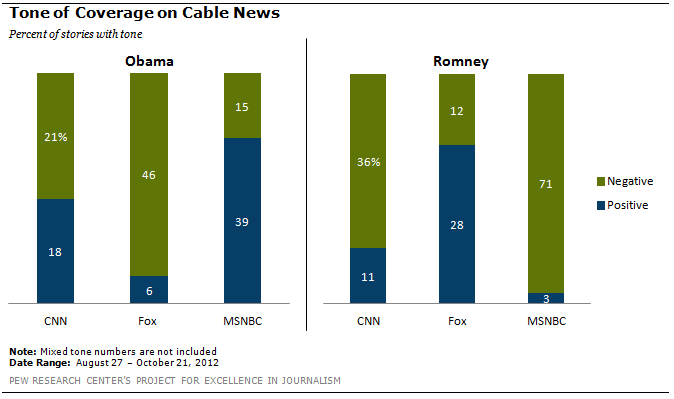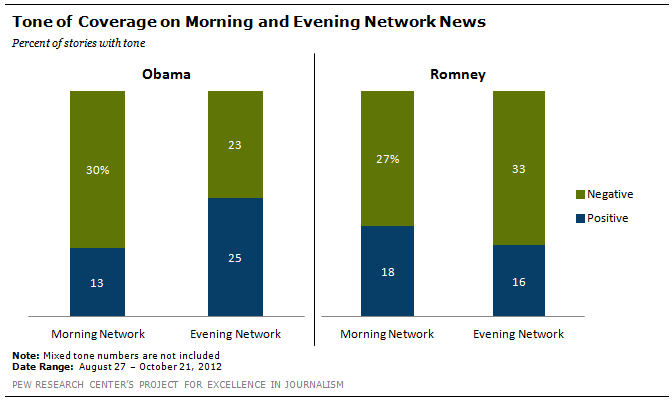In 2008, this study documented a clear and almost mirror-image ideological divide on cable between Fox News Channel and MSNBC. Both MSNBC and Fox deviated from the rest of the media in their treatment of McCain and Obama in roughly equal measure, with MSNBC more positive about Obama and negative about McCain than the rest, and Fox the reverse.
Four years later, that divide has become even more pronounced, and is no longer quite a mirror image. MSNBC was more negative in its treatment of Romney than Fox was of Obama, though both stand out significantly from the rest of the media studied.
Both cable channels also spent more time focused on the candidate that received more negative treatment than they did on the candidate they portrayed positively-especially Fox.

Fox News Channel
On Fox, 28% of the stories about Romney were positive during the eight weeks studied, compared to 12% negative, a difference of 16 percentage points. That stands in significant contrast to the media studied in general here, in which negative stories about Romney exceeded positive by 23 points.
For Obama on Fox, by contrast, 6% of the stories studied were positive while 46% were negative-a difference of 40 points. That compared with an 11-point negative differential for the media in general.
One factor in this difference is that Romney received more positive than negative coverage for horse race on Fox, something that was not true in either the media generally or in any specific sectors studied. More than a third (34%) of the horse-race coverage involving Romney on Fox was positive compared to 15% that was negative-a 2-to-1 difference.
For Obama, by contrast, 11% of the horse-race stories during these eight weeks were positive, while 46% were negative.
Fox aired more negative stories about Obama than positive on every aspect of campaign coverage. When it came to policy, 6% of the stories on Fox about Obama were positive and 51% were negative.
Fox also focused much more on Obama than on Romney. The Democratic Party nominee was a significant figure in 74% of Fox campaign stories compared with 49% for Romney.
That reflects another difference from the channel’s coverage four years ago, when both candidates received more similar levels of coverage. Obama was a significant presence in 66% of Fox News’ stories, compared for 59% for McCain.
MSNBC
If Fox News was a favorable environment for Romney but negative for Obama, the reverse was even more the case on MSNBC.
For Obama, 39% of his coverage on MSNBC was positive compared to 15% negative, a difference of 24 points or close to 3-to-1. That is similar but slightly less positive than in 2008 when 43% of Obama’s stories on MSNBC were positive compared to 14% negative, a difference of 29 percentage points. That puts MSNBC sharply at odds with the rest of the media studied here where there was an 11-point negative differential for Obama.
Yet the bigger difference on MSNBC from the rest of the media was in the coverage of Romney. This year, of the 259 segments studied about Romney during the eight-week period, just 3% were positive in nature while 71% were negative.
Four years ago, 10% of MSNBC’s coverage about McCain was positive while 73% was negative.
MSNBC was especially negative in its treatment of Romney’s policy prescriptions. Fully 75% of the stories focused on Romney’s policies were negative compared with 1% that were positive. For Obama, by comparison, 32% of policy stories were favorable while 18% were negative.
MSNBC also devoted more time on the Republican than on the Democrat; Romney was a significant figure in 68% of the campaign stories on MSNBC versus 53% for Obama; that made it the only outlet studied where Romney received significantly more attention than Obama. In 2008, MSNBC spent more time on McCain, but to a lesser degree; 70% of the stories were on McCain compared to 61% for Obama.
CNN
CNN stood between MSNBC and Fox in its treatment of the two candidates but Obama fared markedly better than Romney and better than in the media generally.
On CNN, 18% of the stories about Obama were positive compared to 21% negative, a mixed narrative. In Romney’s case, negative stories (36%) outnumbered positive (11%) by more than 3-to-1.
However, as with the press studied overall, if one removes horse-race stories from the equation, the tone of coverage of Obama and Romney becomes more comparable. In those stories not framed around the horse race, 13% were positive for Obama compared to 24% negative while 13% were positive for Romney compared to 30% negative.
Unlike its two cable news competitors, CNN also devoted similar amounts of time to both contenders. Obama was a significant figure in 63% of the campaign stories studied compared with 59% for Romney.
The biggest change in CNN coverage of the campaign from four years ago is the number of stories with no clear positive or negative tone. In 2008, about a quarter of the stories for Obama (25%) and McCain (26%) were mixed in tone. In this campaign, the count of balanced stories has more than doubled. In 2012, fully 61% of Obama’s stories were mixed compared to 53% for Romney.
Network TV: Morning vs. Evening
In the closing weeks of the campaign, viewers of commercial network news broadcasts may have gotten different perceptions of the race depending on whether they were watching the morning shows or the evening newscasts.
On network television, the morning shows were among the few places where Romney received better press than Obama-although his coverage was still more negative overall. In the evening, Obama fared considerably better.
During the opening half-hours of the ABC, CBS and NBC morning news programs, which include the leading news of the day, 18% of the stories regarding Romney were positive compared to 27% negative. That overall negative tone was significantly impacted by the horse-race stories. If those strategy stories are removed, Romney’s coverage tipped to the favorable side, with 26% positive and 16% negative.
For Obama in the morning, 13% of his stories were positive compared to 30% negative. And that basic ratio of positive to negative stories changes only minimally if the horse-race stories are removed.

The evening newscasts on ABC, CBS and NBC, however, told quite a different story. There, the narrative about Obama was mixed, (25% of stories were positive, 23% negative) while for Romney, negative segments outnumbered positive by 2-to-1, (16% positive and 33% negative).
This advantage for Obama cannot be explained solely by the horse-race aspect either. If the strategy stories are removed, the tone of coverage for both candidates get slightly better, even though Obama’s (27% positive and 17% negative) is still more positive than Romney’s (17% positive and 25% negative).
The amount of time devoted to each candidate on the morning and evening shows differed modestly. In the morning shows, 77% of the stories included Obama compared to 69% for Romney. For the evening shows, however, the time devoted to each was virtually even with Obama in 67% of the stories and Romney in 64%.

When examining overall campaign coverage (morning and evening together) for the candidates on the three commercial broadcast networks, one of the big three stands out from its rivals.
On ABC, the narrative was modestly favorable for Obama (27% positive, 20% negative) and considerably more unflattering for Romney (18% positive, 33% negative). While the tone of the ABC narrative for Romney is slightly better than in the media in general, Obama does significantly better on that network than in the press overall.
On the other two networks, the tone of campaign stories was virtually the same, and substantially negative, for both men. On CBS, the gap between Obama’s negative and positive coverage was 11 points compared with 14 for Romney.
On NBC, the gap between negative and positive for Romney was 11 points while it stood at 13 points for the president.
Newspapers
For newspapers, 2012 was a very different campaign from four years earlier.
Unlike the media overall, front-page newspaper stories about the 2012 campaign offered a more favorable narrative for Romney than Obama. This year, 19% of Romney’s coverage has been positive compared to 16% negative, while 12% of Obama’s has been positive and 18% negative.
These numbers also represent a significant change from 2008 when Obama enjoyed a large advantage in the tone of newspaper coverage over his rival John McCain. Obama’s positive coverage exceeded negative by almost 2-to-1 while McCain’s negative surpassed positive by about 11-to-1.
Another major change in newspaper campaign coverage from 2008 to 2012 is the dramatic growth in the number of neutral stories published about the candidates. This year, fully 70% of Obama’s stories and 66% of Romney’s newspaper stories were neutral. Previously, only about a quarter of the stories about the major candidates were neutral.


Online
The study also examined the top campaign stories each day of the eight weeks studied on the 12 most popular news websites in the United States. Virtually all of these are websites tied to legacy news organizations or are heavily engaged in aggregation of traditional news.
In the lead stories of the 12 most popular news websites studied, Obama received more favorable coverage than Romney-a difference slightly larger than that of the media overall. And as with the overall press, most of that difference is a result of the horse-race and strategy articles.

Overall, a quarter (25%) of online stories about Obama were positive compared to 33% which were negative. For Romney, 14% were positive while 44% were negative.
However, without the ones focused on strategy and momentum, the numbers are much closer. Among those, only 13% of Obama’s were positive compared with 37% negative, while 10% of Romney’s were positive and 33% were negative.
The advantage Obama has seen online is significant, but not nearly as large as the one four years ago when McCain received more than seven times as many negative stories online as positive.
These numbers may reflect in part the breaking news nature of the top stories at any given moment on websites. In past studies, PEJ has found that the lead stories on websites are often those that are tied to the moment, to newest polls or daily jousting, and sometimes are less analytical than the top election story that appears the next day, even in the same publication’s print edition or that evening’s newscast.




